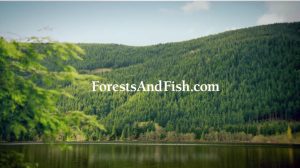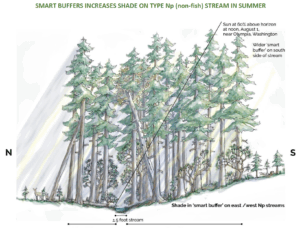WASHINGTON FOREST PROTECTION ASSOCIATION
Landslide Mitigation
A DIVERSE LANDSCAPE
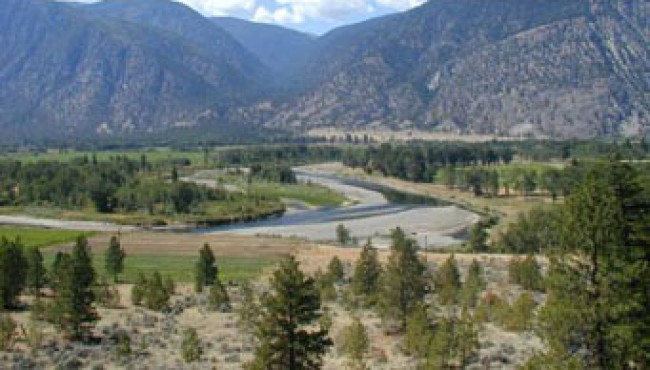
Washington State’s landscape is made up of mountains, rivers, forests and valleys. Mother Nature continues to shape our landscape through dynamic geological activity. This includes slow, gradual changes over time, such as wind and water erosion. There are also sudden and intense changes, such as earthquakes, volcanic eruptions, windstorms, extreme weather events and landslides. The volcanic region of the Pacific Coast is, by nature, one of most landslide-prone areas in the Western Hemisphere.
Landslides occur naturally in forested basins and are an important process in the delivery of wood and gravel to streams. Wood and gravel play significant roles in creating the riparian ecosystem, essential for fish habitat and spawning grounds.
THE ROLE OF LANDSLIDES IN THE ECOSYSTEM
Landslides are a natural geologic process in the steep forestlands of western Washington. They can play an important role in delivering wood and gravel to streams. Sediment and wood are critical elements for creating high quality, diverse stream habitat for salmon, trout, and other aquatic organisms. Historical forest practices caused severe erosion and catastrophic landslides in many river basins that have impacted water quality, fish habitat, and public and private infrastructure. The current forest practices rules are designed to prevent timber harvest and road construction activities from increasing the natural landslide rate and to allow streams to recover from past impacts. On-going scientific research is being used to continuously improve our identification of unstable areas and to ensure that current forest practices are effective at protecting the environment.
For homeowners, learn more in this Guide to Landslides.
Types of Landslides
There are two main types of landslides: Large, deep-seated slides and shallow, fast slides.
Deep Landslides
Slow-moving, deep-seated landslides are those in which the bulk of the slide plane lies below the roots of forest trees. This depth can range from ten feet to several hundreds of feet. These slides tend to be a result of change in the geologic and hydrologic processes in the area of the landslide, such as seismic shaking or increased levels of groundwater. Once formed, deep-seated landslides can persist for a few years, even centuries.
This is an example of a deep-seated landslide. Specifically, this is the western edge of the Nile Landslide that occurred in Yakima County in October of 2009. The road in the bottom left of the photo is Highway 410, which is covered by 50 to 60 feet of sediment.
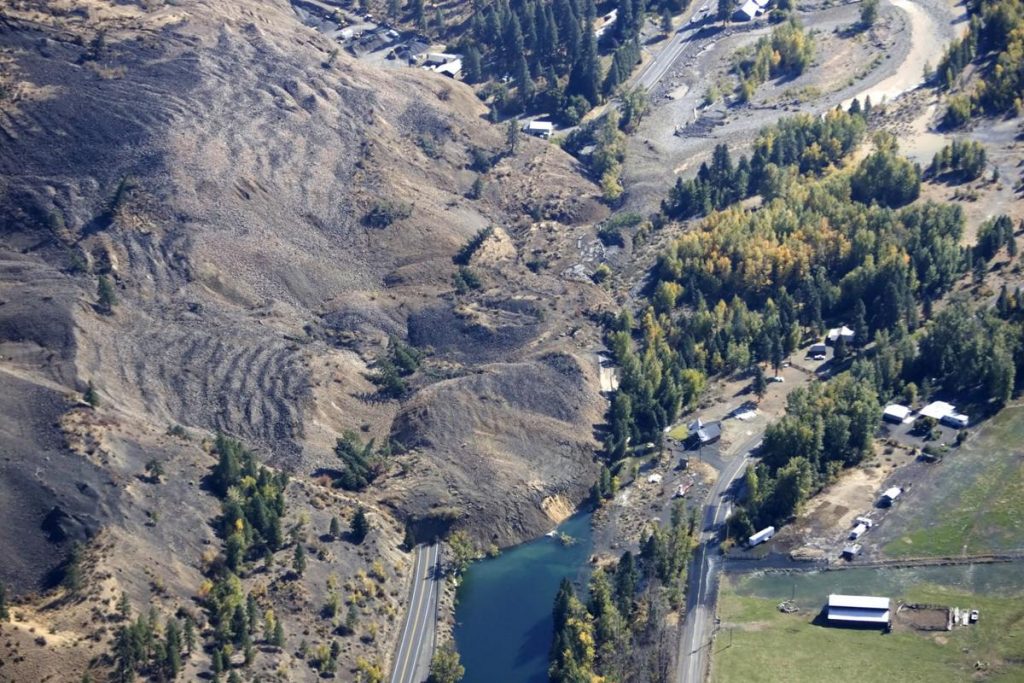
shallow landslides
Fast but shallow debris-flow slides occur within the forest rooting zone, generally less than 10 feet deep. They are typically initiated by intense rainfall and/or rapid snowmelt. Sudden saturation of the ground loosens the soil and triggers the slide. Shallow slides usually follow a long saturation period that is punctuated by an intense burst of precipitation over several hours or a few days. At some point, gravity overtakes the hillside and the muddy soil mass breaks loose. Learn more here.
This is an example of a shallow-rapid landslide. Specifically, Mt. Rainier National Park received 18 inches of rain in 36 hours in November 2006. A 5000 foot long landslide below Stevens Canyon destroyed several campsites and damaged a road. Debris created a major logjam downstream at the bottom of the landslide, across from the Ohanapecosh Campground.
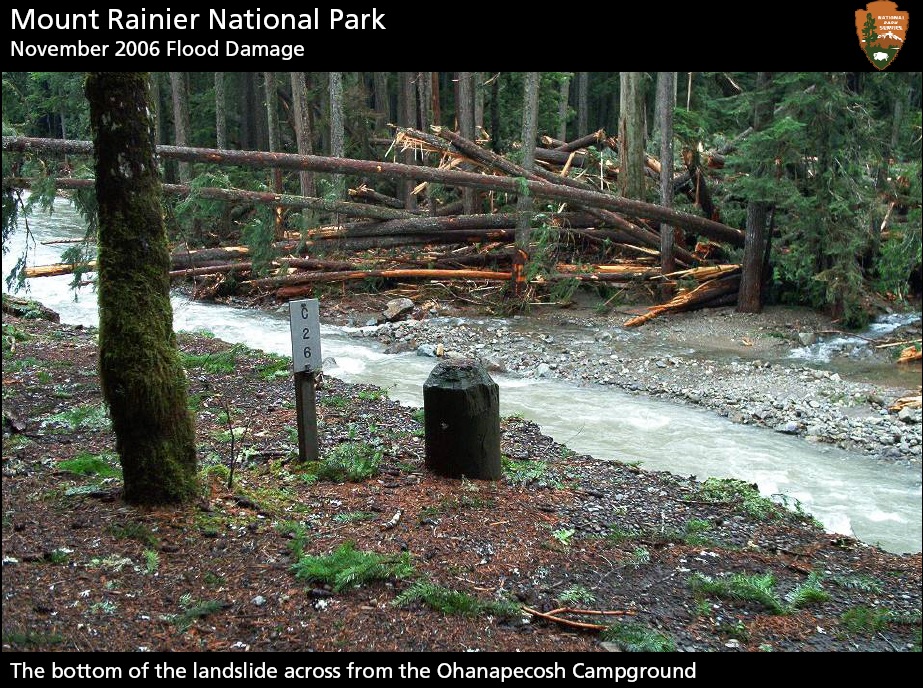
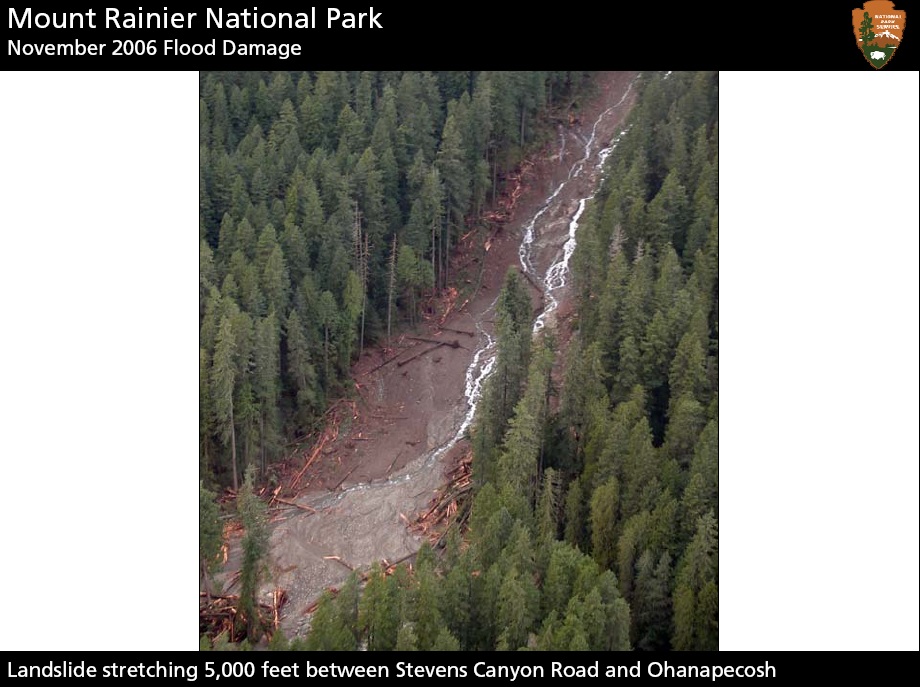
HUMAN IMPACT AND LIMITING LANDSLIDES
FOREST LANDOWNERS AVOID TIMBER HARVESTING IN AREAS SUSCEPTIBLE TO LANDSLIDES
Landslide risk and unstable slopes are addressed in the forest practices rules. Using scientific methods, working foresters have developed accurate ways to identify areas of greatest risk, and seek to avoid timber harvesting in these areas. Landslides are detrimental to private forest landowners, resulting in lost trees and damage to property. Private forest landowners have a vested interest in preventing landslides.
Geologic science has recently revealed that a steep slope is not necessarily a high landslide risk. It depends on soil composition and the specific land formation. The application of science and research is applied daily by the wood products industry to accurately assess landslide danger, prior to the harvesting of trees.
FORESTS & FISH LAW: GOAL NOT TO INCREASE RATE AND MAGNITUDE OF LANDSLIDES
The Forests & Fish Law is a codified system of forest management practices, designed to bring science and sustainability to our state’s working forests. The law was developed by forest landowners, tribes, environmental groups and natural resource agencies. The law specifically addresses the issue of landslide control—with a goal of not increasing the natural background rate or magnitude of landslides as a result of forest practices.
This begins with a scientific protocol that identifies those areas with a high slide potential—and avoiding these areas in commercial forestry sites.
HOW SCIENCE CAN HELP US AVOID LANDSLIDES
When a private forest landowner applies for a permit to harvest trees or build roads, a rigorous screening process is applied before the permit is granted. Modern geologic science has identified six types of landforms that are landslide-prone. Avoiding these areas is the goal. However, in some cases, permission to proceed is granted only after an extensive environmental review and a conclusion by the state’s Department of Natural Resources that the risk is indeed low and tolerable.
RULE-IDENTIFIED LAND FORMS
Forest landowners avoid increasing the natural rate of landslides during forestry harvest operations by avoiding potentially unstable slopes across the landscape, identified in State rule by landform characteristics. When an area is deemed unstable, the default action on the part of private forest landowners is avoidance. This differs from other land uses—such as urban development—where zoning rules seek to mitigate (not avoid) landslide risk by stabilizing steep slopes through drainage, retaining walls and bulkheads.
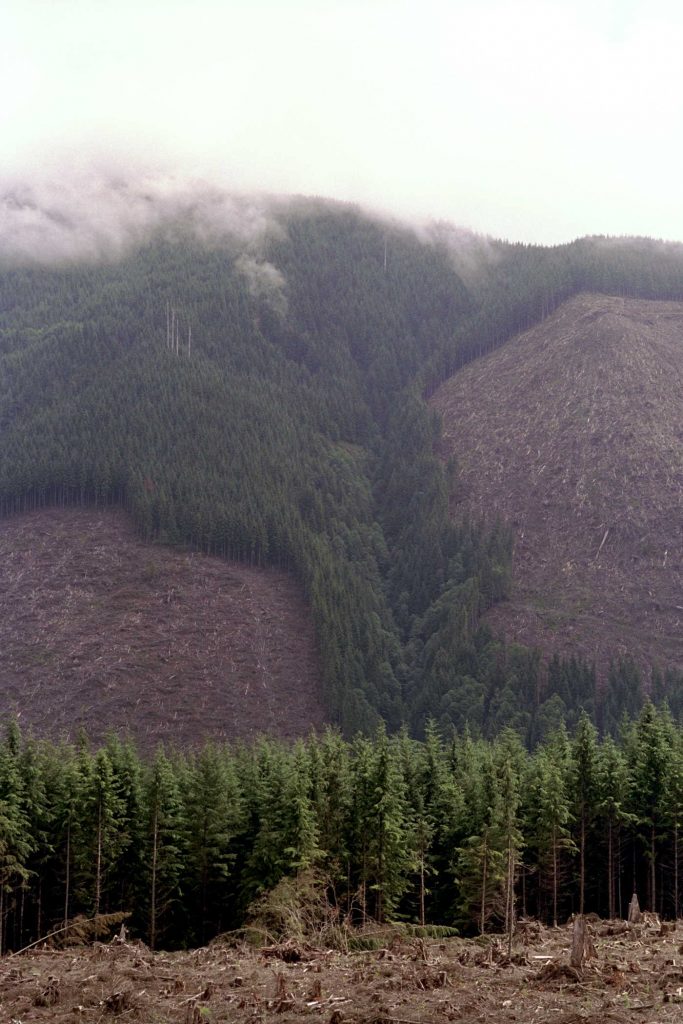
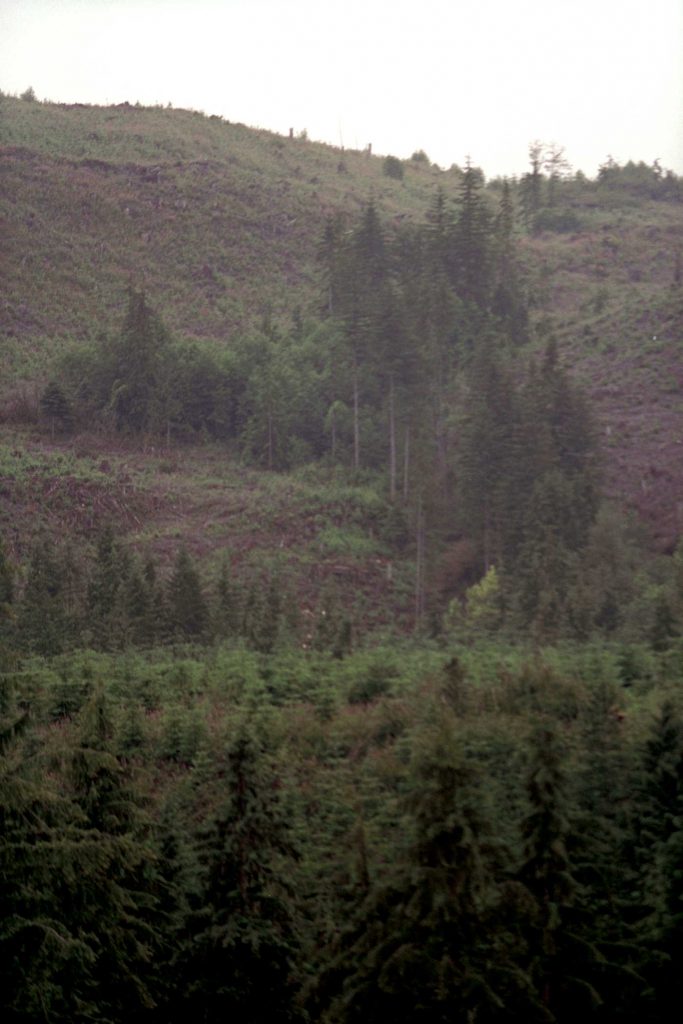
Three of them most common landforms landowners seek to avoid are Bedrock Hollows, Convergent Headwalls and Inner Gorges as illustrated in the above graphic.
WATERSHED ANALYSIS
This is a process that identifies specific watersheds and develops customized “prescriptions”—designed by teams of experts from a wide range of scientific disciplines. The prescriptions identify and explain the geologic characteristics within a particular watershed. This is a valuable analytic tool used by private forest landowners—and the state Department of Natural Resources — to determine the risk probability for landslides in and around these watershed areas.
PROJECT LEVEL DESIGN AND ENGINEERING REVIEW TO AVOID LANDSLIDES
Landowners and DNR—working with highly skilled geologists—utilize a suite of tools to determine areas prone to landsliding prior to approving a Forest Practice Application. These include in-field surveys, mapping, air photos, Landslide Hazard Zonation, modeling programs and other technologies. The end result of field investigation can be a geotechnical report prepared by state geologists who assess the risk of landslides.
Clearly, state law, regulation and best forest practices combine to analyze, identify and prevent landslides that may occur as a result of forest management. These safeguards are in place and well serve the public and the wood products industry.
ADAPTIVE MANAGEMENT PROCESS
Adaptive Management is a structured, iterative process of effective decision making. The goal is to reduce uncertainty over time through thorough and active monitoring of information, accumulating data vital to improving future forest management. It is essentially, “learning by doing”—establishing an ongoing feedback loop that enables us to achieve best forest practices.
The Forests & Fish Law provides a mechanism to apply Adaptive Management to many elements in our working forests—such as water quality, protection of salmon habitat and landslide avoidance.
The Adaptive Management process and system also includes testing to ensure that we are meeting resource goals. Goals and objectives that relate specifically to unstable slopes include:
- Minimizing the delivery of forest management-induced sediment into streams by protecting unstable slopes
- Performance targets for road building and timber harvesting
Virtually no sediment or erosion can be delivered to streams from road building—and timber harvesting cannot increase the natural rate of landslides.
CMER – SCIENCE IN SEARCH OF TRUTH
CMER is the Cooperative Monitoring Evaluation and Research Committee, a program established by the Forest Practices Board and administered by the Department of Natural Resources to ensure that the best available science guides implementation of the Forests & Fish Law. The CMER is currently conducting an extensive “post-mortem” study, in the wake of the December 2007 large-scale rain event, to test whether the Forests & Fish rules have been effective at limiting landslides through the use of improved forest practices. Private forest landowners are participating and engaged in the process of this study. This is another clear example of the science, study and scrutiny that accompanies the land use practices of private forest landowners.
PEER-REVIEWED RESEARCH
All scientific studies evaluated by CMER, whether funded by CMER or not, are peer-reviewed to make certain they have credibility and accuracy. Any participant in the Adaptive Management program can initiate a proposal, whose end-product may affect changes in forest practices. Recent peer-reviewed research conducted by the Weyerhaeuser Company after the storm of 2007 is expected to complement the CMER post-mortem study that is now nearing completion. It provides information on the relationship between landslide rates and intensities to precipitation, age and topography. The study was submitted to the Adaptive Management Administrator, who determines whether proposals are applicable to the process. This study is being recommended for inclusion in assessing issues regarding unstable slopes. In this way, we can ensure that all relevant and credible scientific information may be reviewed to determine how the forest practices rules are working to meet their objectives. The results of this scientific process will be to make recommendations to the policy makers for final consideration before the Forest Practices Board.
EXCESSIVE WATER CAUSES LANDSLIDES
In western Washington, high-intensity rain or rain-on-snow storms are the underlying cause of most shallow landslides. Occurring during the fall and winter months, these warm, persistent weather systems (nicknamed “Pineapple Express”) originate in the waters near Hawaii. As these warm, wet storms move into the state’s higher elevations, they bring heavy rainfall along with rapid snow-melt—the two main ingredients in forest landslides. Some recent examples:
November 2006
Mount Rainier National Park was inundated with 18 inches of rainfall in a 36-hour period. The rain unleashed raging torrents of water in rivers and streams and landslides of mud and rock. The flood was a natural event unlike any other in the park’s 108-year history. Damage to roads and infrastructure forced an unprecedented six-month closure of the park. Click here to see evidence of the storm’s aftermath.
December 2007
An unusually powerful storm in early December 2007 caused record flooding across many areas of southwestern Washington and northwestern Oregon. The highest 24 hour amount for the storm was 14.35 inches, recorded in the Upper Chehalis and Stillman basins—a truly impressive amount of rain. Soaking rains and gravity triggered thousands of landslides.
January 2009
In early January 2009, a combination of heavy rain and melting snow saturated western Washington. Four locations in central and eastern Whatcom County and one location in central Skagit County received between 7.9 and 8.5 inches of rain on January 7th and 8th. Not surprisingly, this set off a series of shallow landslides throughout western Washington.
It is standard practice to conduct an on-the-ground review after major storm events. Soon after the storm, two geologists from the Department of Natural Resources (DNR) began investigating 25 of these landslides. The primary objective of the investigations was to determine if, and to what extent, forest management activities on State Trust Lands contributed to landslide initiation. The full study can be found here.
Of the 25 landslides investigated, 20 began in unmanaged areas while the remaining five originated in managed areas. Of the 20 landslides that began in unmanaged areas, 15 occurred at sites where there was no contribution or influence from forest management activities on State Trust Lands. These landslides took place in undisturbed, mature forest stand—some of which were between 100 and 200 years of age. The five remaining “unmanaged area” landslides originated in areas of mature forest within or along the margins of two recently harvested DNR timber sales.
Of the five “managed area” landslides, four began at sites that were harvested in the late 1980’s or early 1990’s. At the time of that harvesting, Washington’s Forest Practices Rules did not include specific protections for potentially unstable slopes as they do now.
SUMMARY
Washington State’s unique and diverse landscape has always been a source of unstable slopes and landslides—caused by the natural factors of water and gravity. In the last decade, a growing body of scientific knowledge has been applied to the management of forestlands for the express purpose of reducing landslides that result from man-made causes.
Private forest landowners have contributed greatly to the process—along with government, native tribes and environmentalists—in search of best forestry practices based on science. Great strides have been made and we continue to learn through the process of Adaptive Management. There is a rigorous and effective system of regulatory checks and balances in place. Washington State’s private forest landowners are held to some of the world’s highest forest practice standards.
The system is working to not only address the question of landslides—but to create a body of scientific knowledge that will enable us to protect water quality, protect fish habitat and steward our state’s forestlands for the generations that will follow us.

